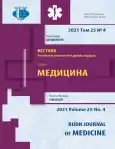Blood pressure time load formation in patients with arterial hypertension without metabolic syndrome
- Авторлар: Zotova T.Y.1, Lukanina A.A.1, Blagonravov M.L.1
-
Мекемелер:
- Peoples’ Friendship University of Russia (RUDN University)
- Шығарылым: Том 25, № 4 (2021): CARDIOLOGY
- Беттер: 282-289
- Бөлім: CARDIOLOGY
- URL: https://journal-vniispk.ru/2313-0245/article/view/319655
- DOI: https://doi.org/10.22363/2313-0245-2021-25-4-282-289
- ID: 319655
Дәйексөз келтіру
Толық мәтін
Аннотация
Relevance . The study of the daily dynamics of blood pressure in arterial hypertension both on the basis of the daily index and on the basis of the time load is a relevant task, since, these indicators are associated in the literature with stable changes in the neurohumoral regulation of the cardiovascular system in arterial hypertension . The aim of the study was to compare data of the time load in patients with arterial hypertension , depending on the nocturnal blood pressure profile, with integrative indicators of the activity of the cardiovascular system in the form of a Circadian index, a structural point of blood pressure, double product. Materials and Methods. The study included 72 patients who were treated at the City Clinical Hospital No 13 in Moscow and signed a voluntary consent to participate in the research and the processing of personal data. Inclusion criteria: arterial hypertension. Exclusion criteria: metabolic syndrome, secondary forms of arterial hypertension and concomitant pathology. Depending on the daily index (DI≥10% and DI≤10%) patients were divided into 2 groups: 1 group (N= 32): patients with arterial hypertension without nocturnal decrease in blood pressure (non-dippers and night-pickers100%); Group 2 (N = 40): patients with arterial hypertension who had a nocturnal decrease in blood pressure (dippers and over dippers 100%). All patients and members of the control group (N=15) underwent daily monitoring of blood pressure (24-hour Arterial Blood Pressure Monitoring). The data were statistically processed to determine the 5% level of significance of differences (p≤0.05) (Student’s test). In the comparative analysis of integrative indicators at day and at night, a variance analysis was applied. Results and Discussion . As a result of the study, it was found that the values of Circadian Index for blood pressure vary depending on the type of night decrease in blood pressure and the blood pressure time load, while daily index and structural point of blood pressure remain on the same level as a reflection of the hemodynamic allostasis existing in both groups. Conclusion. Reflection of the allostatic load on hemodynamics is change of values of double product and of the structural point of blood pressure compared with the control group. These changes are not associated with the peculiarities of the nocturnal blood pressure profile in patients with hypertension without metabolic syndrome.
Авторлар туралы
Tatjana Zotova
Peoples’ Friendship University of Russia (RUDN University)
Хат алмасуға жауапты Автор.
Email: zotovat@mail.ru
ORCID iD: 0000-0002-8415-5506
Moscow, Russian Federation
Anastasiya Lukanina
Peoples’ Friendship University of Russia (RUDN University)
Email: zotovat@mail.ru
ORCID iD: 0000-0002-7486-9257
Moscow, Russian Federation
Mikhail Blagonravov
Peoples’ Friendship University of Russia (RUDN University)
Email: zotovat@mail.ru
ORCID iD: 0000-0001-7838-0486
Moscow, Russian Federation
Әдебиет тізімі
- Shlyakhto EV, Conrady AΟ. Causes and consequences of sympathetic overactivity in hypertension. “Arterial’naya Gipertenziya” (“Arterial Hypertension”). 2003;9(3):81-88. https://doi. org/10.18705/1607-419X-2003-9-3-81-88 (In Russian)
- Tsfasman AZ, Alpaev DV, Karetskaya TD. Diurnal profile of arterial pressure during sleep deprivation in patients with hypertensive disease receiving antihypertensive therapy. Klin Med (Mosk). 2012;90(7):34-7. PMID: 2301997 (In Russian)
- Altman DSh, Davydova EV, Kochetkova NG, Zurochka AV. Growth of biological markers of aging and allostasis in veterans of the Afghan war conflict with early forms of chronic brain ischemia. ESC Heart Fail. 2020;7(6):3487-96. doi: 10.1002/ehf2.13002. (In Russian)
- Zotova TY, Blagonravov ML, Lapaev NN, Denisova AP. Hemodinamic allostasis of pregnant women against the background of preeclampsia. Bulletin of Experimental Biology and Medicine. 2018;165(4):440-444. https://doi.org/10.1007/s10517-018-4189-4 (In Russian).
- Baryshnikova GA, Chorbinskaya SA, Stepanova II. Electrolyte Imbalance and its Role in the Development of Cardiovascular Diseases. Effective Pharmacotherapy. 2019;14:54-60. doi: 10.33978/23073586-2019-15-20-54-60. (In Russian)
- Buckwalter JG, Castellani B, McEwen B, Karlamangla AS, Rizzo AA, John B. Allostatic load as a complex clinical construct: a case-based computational modeling approach. Complexity. 2016; S1:291-306. https://doi.org/10.1002/cplx.21743.
- Atkov OYu, Gorokhova SG. Determinatiob of allostatic load dynamics in the assessment of adaptation in temporary workers in the Arctic. Russian Journal of Occupational Health and Industrial Ecology. 2019;59(9): 547-54. doi: 10.31089/1026-9428-2019-59-9-547-548 (In Russian)
- Merkulov YuA., Pyatkov AA., Gorokhova SG., Merkulova DM., Atkov OYu. Disturbances of Autonomic Regulation of Cardiovascular System at Different Working Regimes with Night Shifts. Kardiologiia. 2020;60(9):62-67. https://doi.org/10.18087/cardio.2020.9.n113 (In Russian)
- Mocayar Marón FJ, Ferder L, Saraví FD, Manucha W. Hypertension linked to allostatic load: from psychosocial stress to inflammation and mitochondrial dysfunction. Stress. 2019;22(2):169- 181. doi: 10.1080/10253890.2018.1542683.
- McEwen BS. Central effects of stress hormones in health and disease: understanding the protective and damaging effects of stress and stress mediators. Eur J Pharmacol. 2008;583(2-3):174-185. doi: 10.1016/j.ejphar.2007.11.071.
- Sterling P. Allostasis: A model of predictive regulation. Physiology & Behavior. 2012;106: 5-15. doi: 10.1016/j.physbeh.2011.06.004.
- Clark MS, Bond MJ, Hecker JR Environmental stress, psychological stress and allostatic load. Psychol Health Med. 2007;12(1):18-30. doi: 10.1080/13548500500429338.
- Romero LM, Dickens MJ, Cyr NE. The Reactive Scope Model - a new model integrating homeostasis, allostasis, and stress. Horm Behav. 2009;55(3):375-89. doi: 10.1016/j.yhbeh.2008.12.009.
- Juster RP, McEwen BS, Lupien SJ. Allostatic load biomarkers of chronic stress and impact on health and cognition. Neurosci Biobehav Rev. 2010;35(1):2-16. doi: 10.1016/j.neubiorev.2009.10.002.
- McEwen BS. Central effects of stress hormones in health and disease: Understanding the protective and damaging effects of stress and stress mediators. Eur J Pharmacol. 2008;583(2-3):174-85. doi: 10.1016/j.ejphar.2007.11.071.
- Schulkin J, Sterling P. Allostasis: A Brain-Centered, Predictive Mode of Physiological Regulation. Trends Neurosci. 2019;42(10):740-752. doi: 10.1016/j.tins.2019.07.010.
Қосымша файлдар









